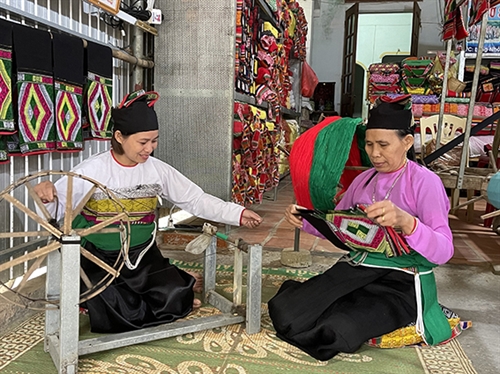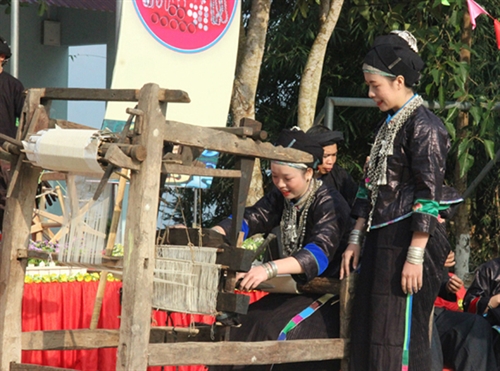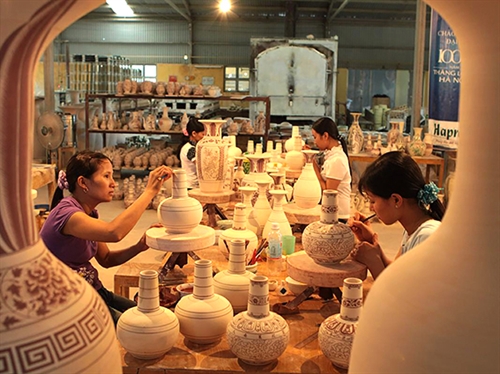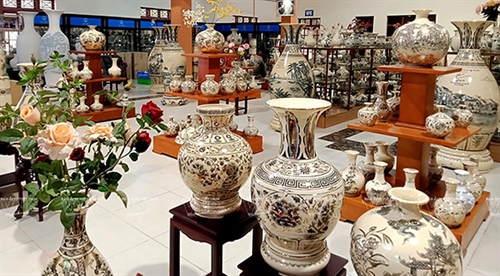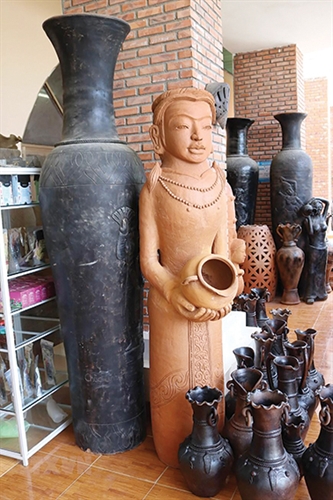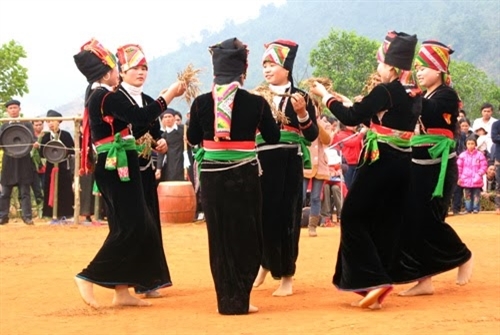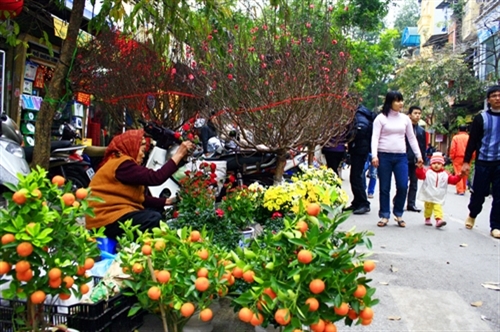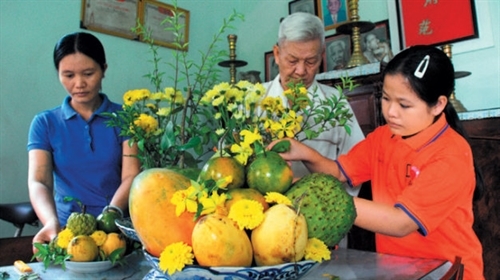Ta Thi Tam
Institute of Anthropology, Vietnam Academy of Social Sciences
The Ta Oi is among 21 Mon-Khmer language ethnic groups with a population of more than 43,800 residing mainly in A Luoi district of Thua Thien Hue province and Huong Hoa and Da Krong districts of Quang Tri province in Central Vietnam.
 |
| Seeding beads on zeng yarns__Photo: https://langnghevietnam.vn/ |
Legend has it that brocade weaving, called kahul in Ta Oi language, was passed on to Ta Oi people by a woman named Canponu, who was believed to be the ancestor of craft, after she learnt it in the heaven. Since then, broadcade weaving has become a cultural tradition passed down from mothers to daughters for generations of the Ta Oi. Ta Oi women spend most of their free time on weaving looms and threads until they cannot see clearly.
Ta Oi girls often start to learn how to weave brocade fabrics, called zeng in the language of the group, around the age of 13. Girls are taught all steps of the weaving process, from preparing materials for weaving, warping a loom and taking threads to weaving different types of products. Brocade weaving is a time-consuming job as it takes a woman one year to wear a six-meter-long piece of zeng fabrics. Hence, in the past, two pieces of zeng fabrics, each is about three meters long, could be exchanged for a buffalo or cow.
Zeng constitutes an indispensable part of Ta Oi daily life. Zeng costumes are not only worn on families’ special occasions, at festivals and weddings but also used as dowry. The first pieces of zeng cloth woven by a Ta Oi girl will be carefully preserved. When the girl grows up and gets married, such zeng cloth will be presented to her future in-laws as a demonstration of her respect and love for the family of her husband-to-be. In her marriage, a Ta Oi girl will always be dressed in costumes made from zeng fabrics woven by herself.
When a Ta Oi man dies, his zeng clothes will be laid in the coffin for the dead to have beautiful costumes to wear in afterlife.
Brocade fabrics of the Ta Oi are made from cotton or jute fibers separated from the woody part of jute stems. Ta Oi people usually grow cotton in early April and harvest cotton bolls in September. Before sowing, the head of the village organizes a ritual to pray the god of the heaven for a bumper crop. After the ritual, strangers are supposed not to enter the village as the Ta Oi believe that a stranger’s appearance will destroy their prayers. Strangers who try to enter the village at this time will be fined. The green branches which are used to fence the village during the ritual will be thrown away after cotton seeds are sown. Fifteen days after sowing, Ta Oi people come to the fields to pull off all weeds.
Weeding must be done until the cotton trees are one meter tall to keep healthy plants to flower. Harvested cotton bolls are dried in the sun for two days. Two rattan back baskets of carefully dried cotton bolls, which are about 50 centimeters in diameter and 25 centimeters tall, can be woven in 10 pieces of zeng fabrics, which is about three meters long and 50-70 centimeters wide each. Cotton bowls are then ginned, bowed, rolled and spun.
Ta Oi women use different forest leaves, tree barks and roots to dye cotton yarn. Major colors include black, yellow, red, green, light blue and purple. They may add kudzu powder or dry sticky rice powder to maintain the color of natural dyes on spun cotton yarn. Dyed cotton yarn is then hung out to dry and wound up into cotton balls.
To weave zeng fabrics, the Ta Oi use simple foldable looms. The loom can be set up almost everywhere. This mobility allows the weaver to work wherever she wants. The loom can also be adjusted to fit any weaver whether she is a little girl starting to learn weaving techniques or an old artisan.
A portable loom is made of 10 bamboo sticks. The warp yarns of the loom are stretched over a weaver’s outstretched legs with one pair of end bars putting against the weaver’s soles and kept tightly by her big, pointer and middle toes and another pair of end bars held in front of the weaver’s belly to roll up the finished cloth. End bars are used to hold the warp (vertical yarns) to two ends of the loom. The loom’s width depends on a cloth’s size which can either be 50 or 70 centimeters. Other parts of the loom include shed sticks that are used to maintain the crossing of the warp’s yarns; a heddle stick that is used to lift alternate yarns of the warp; a bobbin that contains the yarn of the weft and passes from side to side between the warp , and battens that help separate alternate yarns of the warp to allow the bobbin to pass through them. The weaver uses her feet as an anchor to control the tension on the warp. With this simple loom, a weaver can make 10 different types of zeng fabrics.
Apart from plain fabrics, the Ta Oi also use strings of beads, which used to be made of forest seeds and lead and are now made of plastic and copper, to brocade various patterns into zeng fabrics as it is woven. The brocading of forest seed or lead or copper beads has given zeng fabrics their distinctive character. Instead of sticking beads on the cloth’s surface, weavers will break weft yarns to add beads and then knot the two broken yarns before continuing to weave. Millimeter by millimeter, a fabric emerges under the weaver’s skillful fingers. It takes weavers a whole day to brocade a 20cm-long zeng fabric with beads.
Once finished, a piece of zeng fabric has designs featuring triangular and diamond shapes and straight lines and patterns made with these shapes. Other patterns, which describe legendary flowers, leaves, animals and birds, are arranged and woven with various colors. Nowadays, in addition to traditional patterns, the Ta Oi also create several new ones which vary from weaver to weaver. Therefore, each piece of zeng cloth is considered an artistic work reflecting the group’s uniqueness, ingenuity, meticulousness and experiences accumulated for generations.-

